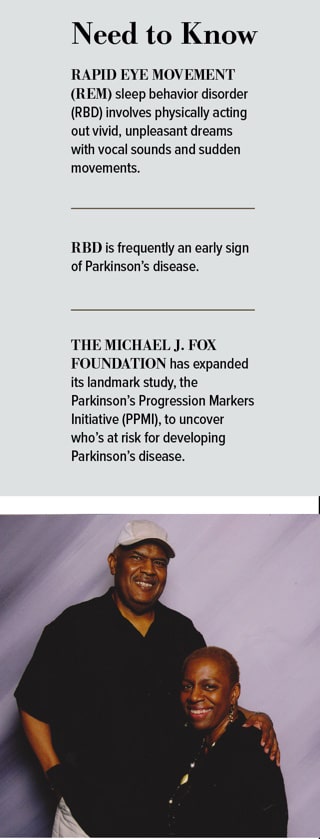A sleep disorder may be a hidden precursor to Parkinson’s disease
Otis Peeples always had vivid dreams. So vivid, in fact, that he regularly acted them out in his sleep. From dreaming he was driving a car to reenacting a Western movie, his movements and behaviors sometimes endangered himself and his wife, Linda.
“One day, he dreamt someone had come into the house with a gun,” Linda says, recalling that during that dream, Otis hit his head on the wall of their Loop apartment. “Another time, he fell off the bed and broke his toe. Occasionally, he’d get violent with me, thinking I was part of his dream.”
Then, Linda saw a television segment about REM sleep behavior disorder (RBD), a condition in which people physically act out vivid, unpleasant dreams with sounds and often violent movements. Linda recognized the scene. She suggested that Otis see a sleep specialist.
“When Linda initially brought it to my attention, I kind of brushed it off. I was a vivid dreamer my entire life, and I just thought it was part of my sleep pattern,” Otis says.
Breaking his toe motivated Otis to see a specialist, who diagnosed him with RBD following a sleep study.
“During REM sleep, typically people are temporarily paralyzed and don’t act out their dreams, so movement during that time of sleep is abnormal,” says NatalieWitek, MD, assistant professor of neurological sciences at Rush Medical College.
REM and RBD
People with RBD don’t experience paralysis during REM sleep, so they physically act out their dreams, said Hrayr Attarian, MD, sleep medicine specialist and medical director of the Northwestern Medicine Sleep Disorders Center. The dreams associated with RBD tend to be action-packed or violent. “People end up dropping out of bed, hitting their head on dressers, breaking bones, or punching bed partners,” Attarian says.
About 70% of injuries during RBD happen to the person dreaming, while 30% of injuries happen to bed partners. However, treatments that relax the body, such as the sedative clonazepam and over-the-counter melatonin, can help prevent injuries.
For Otis, melatonin has made a difference. “My symptoms are not as intense as they were, but I still go through bouts where Linda says I’m talking and kicking in my sleep,” he says.
Otis also reduces the intensity of RBD symptoms by avoiding triggers.
“I know when I eat late at night, am frustrated or anxious, or if I’m tired and haven’t rested well, I tend to have more vivid dreams.”
Parkinson’s connection
Besides risk of injury, RBD also correlates strongly with Parkinson’s disease.
“Patients may have no problems with tremors, slowness, or walking — some of the classic symptoms that are used to make a diagnosis for Parkinson’s disease — but years to decades before, [they] may start to have abnormal movements or behaviors in their sleep, which is a marker that in the future this patient may actually develop Parkinson’s disease or one of the related conditions,” Witek says.

In fact, about 90% of the time, this will lead to either Parkinson’s or Parkinson’s type disorder, such as Lewy body dementia, Attarian says. In people with RBD, imaging studies have shown a decline in dopamine activity in brain areas that control movement, “and when they decline further, they manifest into Parkinson’s,” Attarian says.
When Otis’ doctor raised this possibility, Otis says he initially felt scared. Yet, not everyone with RBD goes on to develop Parkinson’s disease.
Researchers continue to investigate the strong link between the two conditions. The Michael J. Fox Foundation expanded its landmark 2010 study, the Parkinson’s Progression Markers Initiative (PPMI), and is actively recruiting people with RBD symptoms. For more information about the study or to see if you qualify, visit the initiative’s website.
Attarian encourages people with RBD to get involved. “It’s minimal obligation, and if we can find the right marker, we might be able to find something that will protect against the development of Parkinson’s or delay the development of the disease,” Attarian says.
Early detection is vital because by the time many get tested for Parkinson’s disease, they’ve already noticed a change in motor skills. By then, they have a large loss of dopamine-making cells in their brain.
“If we can capture patients at the symptoms of RBD, maybe we can implement something in those earliest stages to try to prevent people from ever developing Parkinson’s motor symptoms,” Witek says.
This powerful connection drove Otis to join PPMI shortly after his RBD diagnosis. “I felt being involved could not only help me, but other people,” he says.
Originally published in the Fall 2022/Winter 2023 print issue.

Cathy Cassata specializes in health, mental health, and human behavior. She connects with readers in an insightful and engaging way.











